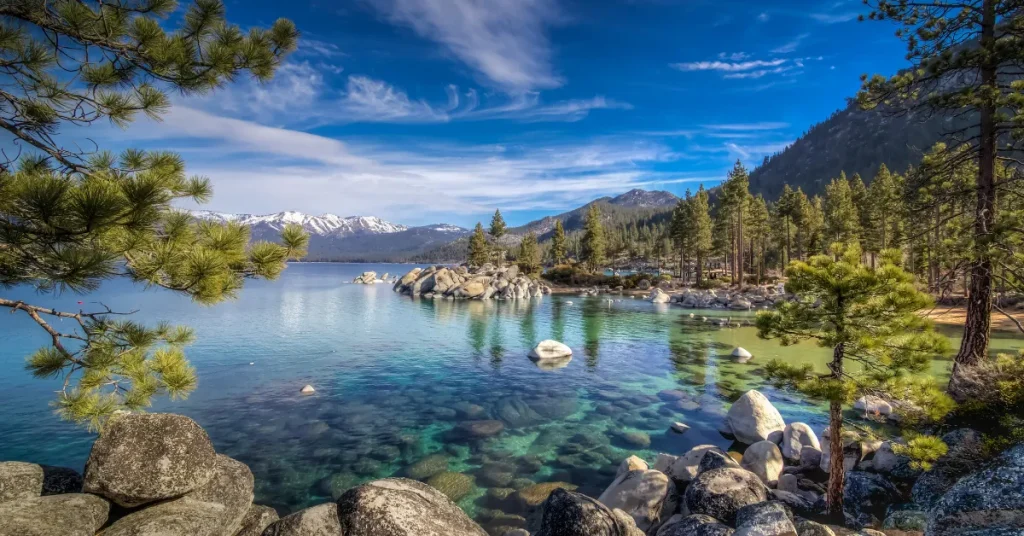Lake Tahoe has a maximum depth of 1,645 feet. It is the second deepest lake in the United States.
Nestled in the Sierra Nevada mountains, Lake Tahoe is renowned for its crystal-clear waters and breathtaking scenery. Spanning the border between California and Nevada, it’s a year-round haven for both adventure seekers and those seeking tranquility.
The lake’s impressive depth not only adds to its majestic beauty but also plays a role in its popularity as a destination for deep-water explorations and various water sports.
Offering a diverse range of activities, from skiing in the surrounding resorts to summer boating, Lake Tahoe is a jewel of natural beauty that attracts millions of visitors each year.
Its deep waters preserve an enchanting world below, enticing divers and researchers alike to uncover its submerged secrets.

Tahoe Lake: A Glimpse Into Its Grandeur
Crystal-clear waters meeting a skyline of majestic mountains, Tahoe Lake stands as a natural wonder.
The lake’s sheer size and beauty captivate visitors year-round. It’s a playground for both summer and winter activities. This natural spectacle is not only a feast for the eyes but also steeped in rich history.
Geography And Vital Statistics
Nestled in the Sierra Nevada mountains, Tahoe Lake is the largest alpine lake in North America.
| Depth | Width | Length | Surface Area | Elevation |
| 1,645 feet | 12 miles | 22 miles | 191 square miles | 6,225 feet |
Vibrant blue colors and crisp mountain air surround this iconic basin. The lake’s volume is a staggering 39 trillion gallons. It means that Tahoe holds enough water to cover California with 14 inches of liquid.
Historical Significance
Lake Tahoe’s history is as deep as its waters. The Washoe Tribe called this place home for thousands of years.
- The name ‘Tahoe’ originates from the Washoe word ‘da ow a ga,’ meaning ‘edge of the lake.’
- In the mid-19th century, the Comstock Lode ushered an influx of settlers.
- By the 20th century, Tahoe became a luxurious escape for the wealthy.
Landmarks like Vikingsholm and the Tahoe Tavern bear witness to this rich past. Today, Tahoe’s allure lies not just in its recreational opportunities but also in its historical tapestry. Indeed, Lake Tahoe is more than just a body of water; it’s a living history book.
Measuring The Depths: Just How Deep Is Tahoe?
Nestled among the Sierra Nevada mountains, Lake Tahoe stands as a wonder of nature. Its crystal-clear waters invite a question that often leaves visitors in awe: just how deep is Tahoe Lake?
This iconic body of water is not only a hub for recreational activities but also a fascinating subject for explorers probing the secrets beneath its azure surface.
Methods Of Depth Measurement
Unraveling the depths of Lake Tahoe requires precision and the right tools. Historically, depth was measured using a simple weighted line dropped over the side of a boat – the line unspooled until it hit bottom.
Modern techniques, however, rely on sonar technology. Echo-sounding equipment sends acoustic signals deep into the waters, capturing depth based on signal return time.
Satellites can also triangulate positions to map the lakebed with astounding accuracy. The work of scientists and technologists has painted a detailed picture of Tahoe’s underwater topography, leading to some remarkable discoveries.
Comparative Analysis With Other Deep Lakes
At an impressive maximum depth of 1,645 feet (501 meters), Tahoe’s waters rank among the deepest in the world. Let’s look at how it stacks up against others:
| Lake | Location | Max Depth (feet) |
| Lake Baikal | Russia | 5,387 |
| Crater Lake | USA | 1,949 |
| Lake Tahoe | USA | 1,645 |
| Great Slave Lake | Canada | 2,014 |
While Lake Baikal in Russia claims the title of the world’s deepest lake, Tahoe proudly holds its own. Its depths surpass those of Oregon’s Crater Lake and even outdo the dramatic abysses of the Great Slave Lake in Canada.
With such impressive statistics, Tahoe Lake enjoys its reputation as a remarkably deep and majestic waterbody in North America.
The Secrets Beneath: Exploring Lake Tahoe’s Underwater Terrain

Discover the depths of Lake Tahoe’s underwater terrain, a world teeming with intrigue and hidden wonders. Below the sparkling surface lies a landscape as captivating and diverse as any found on land.
Unveiling its secrets offers a glimpse into a mysterious aquatic realm that continues to fascinate scientists and adventurers alike.
Unique Subaquatic Features
Below Lake Tahoe’s waves lies an extraordinary world. Its dazzling clarity reveals a variety of unique underwater formations:
- Underwater Mountain Ranges: Contours mimic those on land.
- Steep Drop-offs: The lake’s basin plunges abruptly, creating dramatic scenery.
- Massive Boulders: Geologic marvels scattered across the lakebed.
These features create a hidden geography just as complex and wondrous as any forest or mountain pass. Sunken trees, known as “ghost forests,” stand silent watch over this secluded sanctuary.
Scientific Expeditions And Discoveries
Secrets of Tahoe’s depths emerge through scientific quests. Recent missions have brought to light new insights:
- Revelations about Lake Tahoe’s basin structure and its seismic history stir scientific communities.
- Discoveries of species diversity inform ecological stewardship.
- Studies of the water’s purity guide conservation efforts and ensure the lake’s continued splendor.
This underwater terrain offers limitless potential for discovery, reminding us of the depths still to explore and the knowledge yet to surface from this azure sanctuary.
Tahoe’s Ecology: Life In The Deep
Unraveling the mysteries of Tahoe Lake begins with a dive into its depths. At over 1,645 feet deep, the lake creates an extraordinary under-water world.
This thriving aquatic ecosystem is home to a variety of species, some found nowhere else on Earth. Let’s explore the unique inhabitants and the impact of Tahoe’s impressive depth on its ecological balance.
Endemic Species And Habitats
Tahoe Lake cradles an array of endemic species—creatures native to this locale. This biodiversity hotspot includes fish, invertebrates, and plants that have adapted to the lake’s conditions.
- Lahontan cutthroat trout: Once thought extinct, thriving again.
- Tahoe suckerfish: Navigates the lakebed, a vacuum cleaner of the deep.
- Mysis shrimp: Tiny yet vital, a food source for fish.
Their habitats range from rocky shallows to steep, dark depths. Protected coves and vast expanses of cold blue give life to these remarkable creatures.
The Impact Of Depth On Ecological Balance
The lake’s depth profoundly shapes the ecosystem’s dynamics. Cold, oxygen-rich layers support deep-water species. Water pressure and temperature gradients create distinct niches for wildlife.
- Water Clarity: Reduced light penetration limits plant growth.
- Temperature Zones: Thermal stratification dictates species distribution.
- Pressure: Life adapts to intense conditions in the abyss.
Thriving in such an environment demands specialized adaptations, contributing to the unique nature of Tahoe Lake’s underwater ecology.
Myths And Legends: Tahoe’s Deepwater Mystique

Lake Tahoe, with its dazzling blue waters, has always been shrouded in mystery. Beyond its breathtaking beauty lies a world of tales and intrigue, where the depth of the lake fuels legends and myths that capture the imagination.
Cultural Tales And Unsolved Mysteries
Native American tribes have revered Lake Tahoe for centuries. Stories passed down speak of water spirits and hidden depths. One legend claims a Loch-Ness-like creature, named Tahoe Tessie, dwells within the lake.
Underwater explorations reveal steep drop-offs, yet no sign of Tessie. Divers and scientists wonder what secrets the depths may hold. Mysteries like these add to the lake’s allure.
Modern Myths And Tourist Attractions
Lake Tahoe’s mystique has given rise to modern tales. The lake’s depth – 1,645 feet at its deepest point – lends credibility to these stories. Some say mobsters used the lake to dispose of evidence, captivating crime enthusiasts.
- Scuba diving trips offer a glimpse into the underwater world.
- The Maritime Heritage Trail showcases historic sunken boats.
- Guided tours recount tales of old, sparking tourists’ curiosity.
Attractions like this not only celebrate the lake’s natural splendor but also its storied past. Tourists leave with a sense of wonder, the lake’s mysterious depths a backdrop for their newfound tales.
Preserving Tahoe’s Depths: Conservation Efforts
Lake Tahoe, a majestic natural wonder, holds the title as one of the deepest lakes in the United States. Nestled in the Sierra Nevada mountains, it reaches depths of over 1,600 feet.
Protecting this treasure requires ongoing efforts. Let’s dive into the initiatives safeguarding Lake Tahoe’s stunning depths and clarity.
Environmental Challenges And Initiatives
Lake Tahoe faces several environmental challenges, stretching from pollution to invasive species. Efforts to preserve its waters are critical.
- Water Clarity: Conservation teams work tirelessly to maintain the lake’s famed clarity.
- Invasive Species: Programs aim to control and prevent harmful species from disrupting the ecosystem.
- Pollution Control: Strict regulations limit pollutants, safeguarding the lake’s water quality.
Nonprofit organizations and government entities collaborate to fund and execute preservation projects.
Sustainable Tourism And Future Prospects
Lake Tahoe’s allure draws countless visitors annually. Sustainable tourism is key to its future.
- Eco-friendly Practices: Lodges and tour operators promote green initiatives.
- Visitor Education: Programs inform tourists about conservation and responsible behavior.
With combined efforts from locals and visitors, Lake Tahoe continues to be a pristine destination.
FAQs About How Deep Is Tahoe Lake
What Is The Depth Of Lake Tahoe?
Lake Tahoe’s depth reaches a maximum of 1,645 feet, making it the second-deepest lake in the United States. Its significant depth contributes to its famous clarity and beautiful blue color.
How Does Tahoe’s Depth Compare To Other Lakes?
Lake Tahoe is the world’s 16th deepest lake, and among US lakes, only Crater Lake in Oregon is deeper. Tahoe’s depth places it among the deepest globally, showcasing its unique geological features.
Where Is The Deepest Point In Lake Tahoe?
The deepest point of Lake Tahoe is located near Crystal Bay. It plunges to a depth of approximately 1,645 feet. It’s an area of significant interest for researchers and scientists studying the lake’s ecology.
How Was Lake Tahoe’s Depth Measured?
Lake Tahoe’s depth has been measured using sonar technology. Sophisticated equipment sends sound waves to the bottom of the lake, and measures the time it takes for the waves to return, accurately mapping the depth.
Conclusion
Tahoe Lake’s depth is truly impressive, reaching depths of over 1,600 feet. This natural wonder captivates visitors with its stunning clarity and vibrant ecosystem.
Remember, its vast waters hold secrets and histories worth exploring time and time again. Dive into its beauty on your next adventure.
Resources:
1. https://parks.nv.gov/parks/lake-tahoe-nevada-state-park
